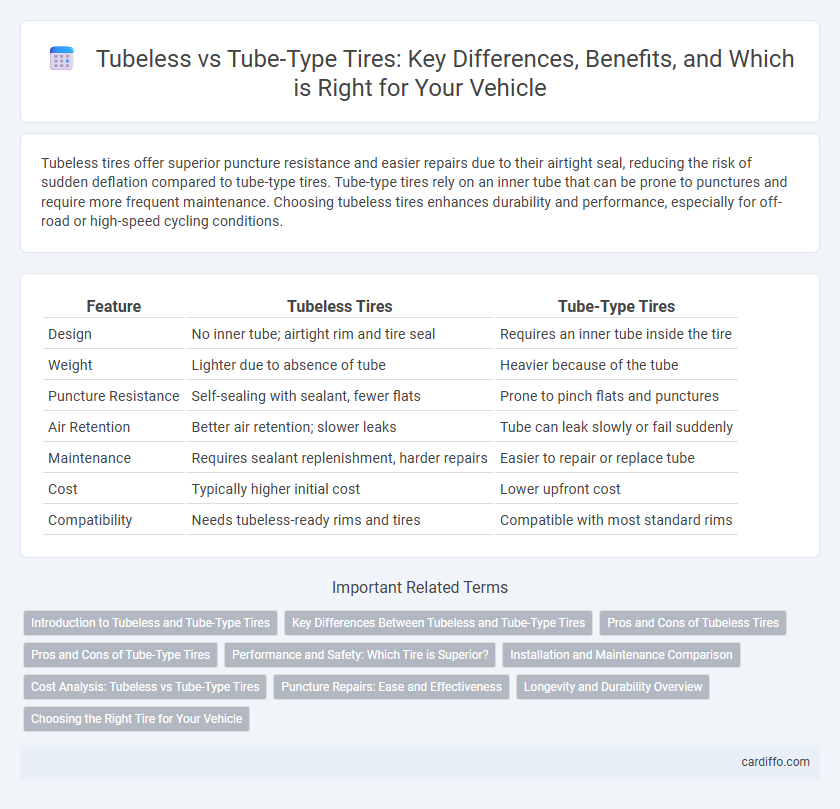Tubeless tires offer superior puncture resistance and easier repairs due to their airtight seal, reducing the risk of sudden deflation compared to tube-type tires. Tube-type tires rely on an inner tube that can be prone to punctures and require more frequent maintenance. Choosing tubeless tires enhances durability and performance, especially for off-road or high-speed cycling conditions.
Table of Comparison
| Feature | Tubeless Tires | Tube-Type Tires |
|---|---|---|
| Design | No inner tube; airtight rim and tire seal | Requires an inner tube inside the tire |
| Weight | Lighter due to absence of tube | Heavier because of the tube |
| Puncture Resistance | Self-sealing with sealant, fewer flats | Prone to pinch flats and punctures |
| Air Retention | Better air retention; slower leaks | Tube can leak slowly or fail suddenly |
| Maintenance | Requires sealant replenishment, harder repairs | Easier to repair or replace tube |
| Cost | Typically higher initial cost | Lower upfront cost |
| Compatibility | Needs tubeless-ready rims and tires | Compatible with most standard rims |
Introduction to Tubeless and Tube-Type Tires
Tubeless tires feature an airtight seal between the tire and rim, eliminating the need for an inner tube and reducing the risk of sudden air loss during punctures. Tube-type tires incorporate a separate inner tube that holds the air, making repairs simpler but potentially more prone to punctures and blowouts. Advances in tubeless tire technology provide better fuel efficiency, improved safety, and enhanced durability compared to traditional tube-type tires.
Key Differences Between Tubeless and Tube-Type Tires
Tubeless tires eliminate the inner tube, relying on an airtight seal between the tire and rim, which reduces the risk of sudden air loss and improves fuel efficiency. Tube-type tires require an inner tube, increasing weight and the probability of punctures leading to rapid deflation. Tubeless tires offer better heat dissipation and enhanced durability, making them preferable for modern vehicles and off-road applications.
Pros and Cons of Tubeless Tires
Tubeless tires offer advantages such as reduced risk of sudden deflation, better heat dissipation, and improved fuel efficiency due to lighter weight. They require airtight rims and may be more expensive to repair when punctured compared to tube-type tires, which use an inner tube that is easier and cheaper to replace. However, tubeless tires provide better performance in off-road conditions and enhanced safety, making them a preferred choice for many modern vehicles.
Pros and Cons of Tube-Type Tires
Tube-type tires offer compatibility with a wide range of wheel designs, making them versatile for various bicycle and motorcycle models. They provide easier patch repairs in case of punctures, which can be advantageous during long rides without access to replacement tires. However, tube-type tires are more prone to pinch flats and generally add extra weight compared to tubeless tires, impacting overall ride efficiency.
Performance and Safety: Which Tire is Superior?
Tubeless tires offer superior performance by maintaining consistent air pressure and reducing the risk of sudden deflation, enhancing vehicle stability and control. Their design eliminates the inner tube, decreasing the chance of punctures and improving heat dissipation, which contributes to longer tire life and safer driving conditions. Tube-type tires may be easier to repair but generally fall short in performance and safety compared to the advanced reliability and durability of tubeless tires.
Installation and Maintenance Comparison
Tubeless tires offer easier installation by eliminating the need for an inner tube, reducing the risk of pinch flats and simplifying the mounting process on compatible rims. Maintenance of tubeless tires requires periodic sealant checks and refills to maintain airtight integrity, whereas tube-type tires demand more frequent tube replacements and patch repairs due to punctures. The seamless fit of tubeless tires enhances durability and performance, while tube-type tires involve more complex installation steps and higher maintenance frequency.
Cost Analysis: Tubeless vs Tube-Type Tires
Tubeless tires generally offer lower long-term costs due to fewer puncture repairs and extended tire life compared to tube-type tires, which often require frequent inner tube replacements. Initial purchase prices for tubeless tires can be higher, but savings accumulate from reduced maintenance and improved fuel efficiency due to lower rolling resistance. Cost-effectiveness is further enhanced by the availability of tubeless tire sealants that prevent air loss without the need for immediate repairs.
Puncture Repairs: Ease and Effectiveness
Tubeless tires allow for easier and more effective puncture repairs since they often self-seal small holes using sealant inside the tire, reducing the need for immediate intervention. In contrast, tube-type tires require removing the tire to patch or replace the inner tube, which is more time-consuming and less convenient. The airtight nature of tubeless tires enhances durability and minimizes air loss during minor punctures, improving overall riding reliability.
Longevity and Durability Overview
Tubeless tires offer enhanced longevity due to their airtight seal that reduces air loss and resists punctures more effectively compared to tube-type tires. The lack of an inner tube minimizes friction and heat buildup, significantly improving durability under various road conditions. Tube-type tires are more prone to pinch flats and require frequent maintenance, making tubeless tires a more reliable long-term option.
Choosing the Right Tire for Your Vehicle
Tubeless tires offer improved safety and performance by eliminating inner tubes, reducing the risk of sudden deflation and enhancing heat dissipation. Tube-type tires remain a cost-effective option, especially for older vehicles and off-road conditions, providing easier repairs in case of punctures. When choosing the right tire for your vehicle, consider factors such as driving conditions, vehicle type, and maintenance preferences to ensure optimal safety and efficiency.
Tubeless tires vs tube-type tires Infographic

 cardiffo.com
cardiffo.com